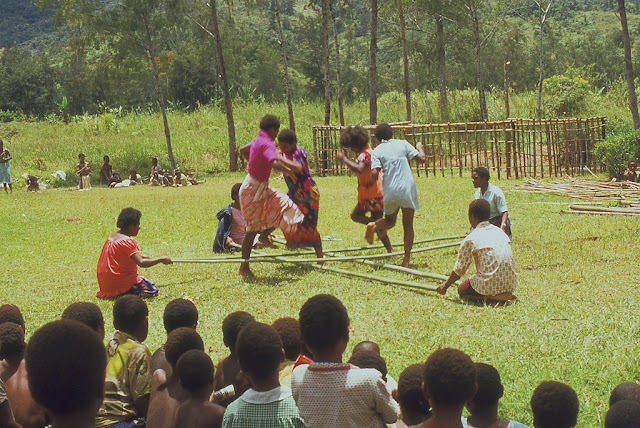Start
here for my introductory blog about our experiences in PNG.
Mt Hagen High School had about 300 students, with about 200 boarders, both boys and girls on site. A staff compound was also on site.
My job was as head science teacher but also mentor to a local teacher to help him become a better one. The PNG culture was to have a major impact on him later in the year.
In some future blogs I will outline what happened when payback reared its head in Mt Hagen. The school grounds however were highly regarded as neutral territory and safe from tribal conflict. Even Europeans were fair game outside school if you transgressed.
 |
| Local art on a classroom. |
 |
| School grounds and garden in foreground. School house on other side of field. |
 |
| School houses and gardens from nearby hill. |
The warm dry Highlands climate in the winter lead to many outdoor BBQs around the haus wind.
The school grounds are dominated by the Cultural Centre built on a small hill. The grass huts of which there were at least 12 mostly differed and were built according to the tribal huts peculiar to individual tribes.
 |
| Hut with door at the end rather than across the front. |
Unfortunately I did not photograph all other shuts the show the different styles. In some districts the huts were round (Chimbu District) and long houses were common in the Southern Highlands.
 |
| Mid Waghi hut at the Cultural Centre. |
The school day started with lessons at 0730 hrs until 1330 hrs. After that was Work Parade until 1500 hrs. During this time, the students took part in looking after the school grounds, e.g. weeding and tending to the extensive gardens at the Cultural Centre which provided some food for the hostels.
After work parade, town students could go home whilst boarders were able to go to their huts at the Cultural Centre.
 |
| At least 3 boys in their hut having a brew up. |
 |
| Boys outside another house at the Cultural Centre. |
All the huts were of course made from locally obtained materials. I wouldn't think that steel nails would have been used.
One afternoon when chatting with some boys at the centre, I asked if there were any snakes around. What a challenge! They all dived into the long grass and emerged a few minutes later each triumphantly clutching a small, apparently harmless grass snake.
{As an aside, we were driving back to Mt Hagen one Sunday afternoon when I saw some smoke coming out of a hut. A quick stop and grab of the camera saw the photo below taken.
 |
| Grass hut fire |
Immediately the photo was taken, someone emerged out of the smoke and flames and ran to the right. I assume to jump in a nearby stream. By the time I go over the shock of this and wound the film on and recomposed for the next photo, perhaps 30s elapsed between shots.
 |
| The hut 30s later. |
In less than 5 minutes after we stopped, there was nothing left apart of smoking bare ground.}
Back to Mt Hagen High School.
A master carver from the Sepik District worked in the school grounds creating some fantastic sculptures out of beautiful timber.
 |
| John, the carver from The Sepik |
We were so impressed by the quality of John, the master carver's work, that we commissioned him to workem onepela lik lik pela puk puk. (make us a small crocodile carving which still graces our home today.)
 |
| Carving around the school |
 |
| Larger than life carving |
 |
| Puk puk (crocodile) down the back. |
Local culture and sport played a big part in school life. The Rakanda Players put on a great demonstration of games payed in the villages.
 |
| Rakanda Players |
 |
| Rakanda Players |
 |
| Sports Day |
 |
| Sports Day march past |
 |
| Javelin throw |
My next blog takes us to the Chimbu District.




No comments:
Post a Comment